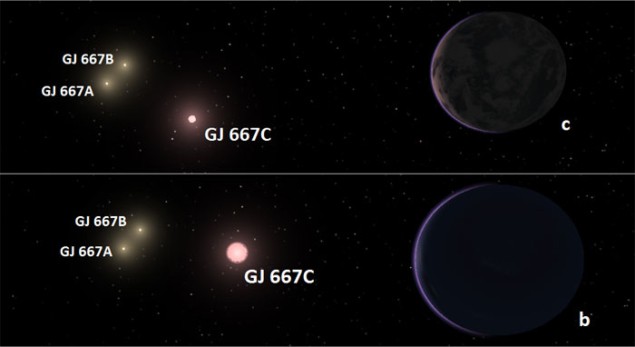
An international team of scientists has discovered a potentially habitable super-Earth orbiting within the habitable zone of a cool star that is a member of a triple-star system. This discovery demonstrates that habitable planets could form in more varied environments than previously thought. This is the fourth exoplanet found within the habitable zone of a star – the first being Gliese 581d, which was discovered last May. Super-Earth planets are two to 10 times more massive than Earth.
Led by Guillem Anglada-Escudé and Paul Butler from the Carnegie Institution for Science in the US, the team studied public data released by the European Southern Observatory, as well as incorporating new measurements from the Keck Observatory’s High Resolution Echelle Spectrograph and the new Carnegie Planet Finder Spectrograph at the Magellan II Telescope. The researchers were looking for stars with small “wobbles” in their orbit – a common marker for an exoplanet that is caused by the pull of the planet’s gravity.
Hidden planets
Among the data was GJ 667C – an M-class dwarf star 22 light-years from Earth that had been known to have a super-Earth (called GJ 667Cb) that orbited the star in only 7.2 days. The planet’s exceedingly short orbit made it too hot to support life, previously rendering it uninteresting. Moreover, the other two stars in the triple system are a pair of orange K-class dwarfs with a concentration of heavy elements – those heavier than hydrogen and helium – only 25% that of the Sun. As such elements are the building blocks of rocky, terrestrial planets, astronomers had not expected the system to have an abundance of low-mass planets. But after carefully analysing the data, the team was surprised to find a clear signal of a new planet – GJ 667Cc – that has an orbital period of 28.15 days and a minimum mass of just 4.5 times that of Earth.
The new planet receives 90% of the light that Earth receives. However, because most of the incoming light for the M-class dwarf star is in the infrared, a higher percentage of this energy must be absorbed by the planet. Taking both these effects into account, the researchers believe that the planet absorbs about the same amount of energy from its star as the Earth absorbs from the Sun.
This means that the surface temperature is similar to Earth, in turn raising the tantalizing possibility that liquid water exists on the planet’s surface. Confirming this hypothesis will, however, require further information about the planet’s atmosphere. “This planet is the new best candidate to support liquid water and, perhaps, life as we know it,” says Anglada- Escudé.
Another home?
The team notes that the system might also contain two other planets – a gas-giant planet, like Jupiter, as well as a third super-Earth with an orbital period of 75 days. However, further observations will be needed to confirm these two possibilities. “With the advent of a new generation of instruments, researchers will be able to survey many M-calss dwarf stars for similar planets and eventually look for spectroscopic signatures of life in one of these worlds,” says Anglada- Escudé.
Lewis Dartnell, an astrobiologist from University College London, says that while the discovery of a new “potentially rocky exoplanet orbiting within a star’s habitable zone is very intriguing, it is important to note that the star in question is an M-class dwarf star”. He goes on to say that such stars can be rather unstable and this would spell trouble for an orbiting planet. “In addition, as such exoplanets would tend to be tidally locked, the climate on the planet would be extreme – with arctic-like conditions on the side of the planet where there is always darkness and never-ending day on the lit side. This might make life on such a planet all the more difficult,” he says.
The work is to be published in Astrophysical Journal Letters. A preprint is currently available on arXiv.




